July 2023

World Premiere Review!
Metronome Audio Le DAC 2 Review
The Spice must flow.
Review By Paul Schumann
It’s no secret that Hollywood has become the land of the sequel. Nine of the top ten grossing movies from 2022 were sequels. I excluded The Batman because it technically wasn’t a sequel, but it was a reboot, for goodness’ sake. Now I’m not going to bash sequels out of hand. I watch a bunch of them myself. My big complaint is when a sequel is done by a different set of writers and a new director and is so different from its predecessor in tone and theme that about halfway through I throw up my hands and ask, “Why am I watching this?”.
One sequel I’m looking forward to watching is Dune: Part 2. While they call it a sequel, it’s more of a continuation of the first movie with Denis Villeneuve and his team completing the task. Even though I’ve only seen 2.5 minutes of it in a trailer, I am incredibly hopeful that this crew will bring the ship safely into the harbor. Yes, I could be wrong, but like Fremen, I believe.
Why Sequels?
Why am I talking about sequels? Because, for the first time in my reviewing career, I’ve had the opportunity to listen to an updated version of a product I reviewed previously. Back in 2019, (doesn’t that seem like a long time ago?), I was fortunate enough to have the original Le DAC in my home. It was the first true high-end DAC I’d ever listened to, and its technicolor presentation of the music blew me away. That led to it winning a richly deserved Blue Note award. I didn’t actively pursue to review the Le DAC 2, as fate would have it, I was fortunate enough to get it sent my way. But then, I had a twinge of anxiety. Would it be as I remembered the first Le DAC? As the Bene Gesserit Reverend Mother Gaius Helen Mohiam said, “Hope clouds observation.”
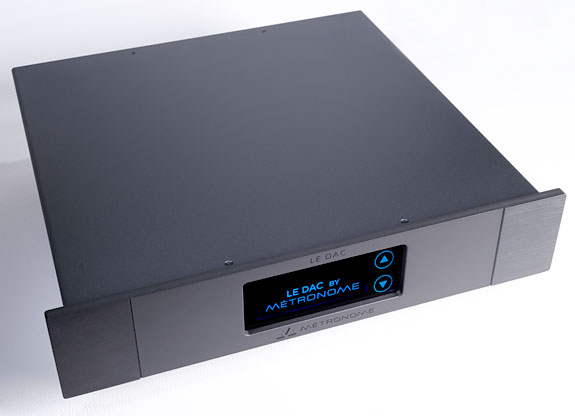
So why a Le DAC 2? Wasn’t the first one amazing and gave me the technicolor dream? As it turns out, the good people at Metronome Audio were dealt a hand where they had to make a change. The original Le DAC utilized the Asahi Kasei AK4493 conversion chip. Unfortunately, in October 2020, the Asahi Kasei factory experienced a devastating fire, cutting off the supply of their chips. Once Metronome started to run out of AK4493 chips, they needed to start with a clean sheet of paper.
Thankfully, Metronome found a successor in the ES9028PRO chip This 32-bit DAC chip has a patented time-domain jitter eliminator and a THD compensation circuit. This chip is designed for both audiophiles and professional use and is manufactured by ESS Technology. While it is cool that they found a new chip to their liking, they had to redesign all of their circuitry to accommodate it and dial in the sound. So as far as the insides go, the Le DAC 2 is a very different critter for the first Le DAC.
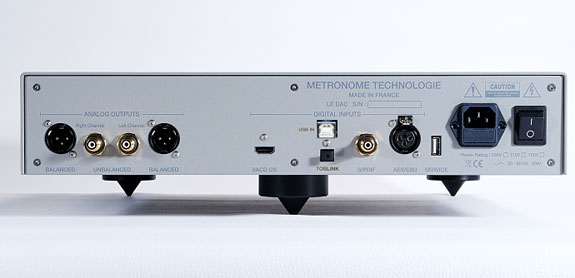
From the outside, Metronome Audio’s Le DAC 2 is nearly identical to its predecessor. It has the same chassis made of battleship armor. The same inputs and outputs. Even the same cool-blue display. The only external difference is soft-touch buttons replacing the silver toggle switches from before. The unit I reviewed was finished in a gorgeous flat black which exudes luxury. Just like the original, there is no remote. This DAC is about as plug-and-play as it gets.
Before I continue, I need to discuss my anxiety when I received the Le DAC 2. As I said, the Le DAC was the first high-end DAC I had ever reviewed. I have made several upgrades to my system since then, making it more revealing. Even the connection between my transport and the DAC has changed from TosLink optical to S/PDIF RCA coax. One step I took to make things equivalent was to hook one set of outputs of the Le DAC 2 directly to my headphone amp and Grado headphones, which were the same as the last time. So while I did spend a lot of time listening to the Le DAC 2 through my complete system, I used my headphone setup as a touchstone. But alas, auditory memory is a tricky thing. As Leto Atreides II said, “It is difficult to live in the present, pointless to live in the future, and impossible to live in the past.”
How did Leto II know this? Growing up on the planet Arrakis, Leto II was constantly exposed to the Spice Melange. The Spice expanded his consciousness and gave him not only prescience but the ability to access the memories of his ancestors. The Spice also awakened dormant parts of his mind and encouraged expanded sensory perceptions. In many ways, I liken high-end premium audio equipment to Spice. It allows you to experience a musical performance that happened before your birth vividly. Some pieces utilizing new technology will enable you to see the future of audio.
Additionally, continued listening to high-end audio equipment rewires your auditory senses so you become more sensitive to the aural matrix. This can lead to amazing moments when you are listening to a beloved piece of music and you can connect to the music in a deeper and more meaningful way. Like the Spice, the Metronome Le DAC 2 accomplishes that.

Listening To Metronome Audio’s Le DAC 2
One of my favorite pieces of music is Vaughan Williams’ Symphony No. 3, ‘A Pastoral Symphony’. Andre Previn and the LSO recorded the entire symphony cycle back in 1971 and this performance is one of the highlights. I know the RCAs from that period weren’t always the best, but I don’t care. It’s the performance I’m after. The whole symphony is sublime, but the last movement is extraordinary. Starting with a haunting wordless soprano voice over a drum roll, then followed by the strings and woodwinds, this entire movement is a sorrowful lament to those lost in WW I.
With Metronome Audio’s Le Dac 2, the strings sounded lush and full, contrary to previous listening. The woodwinds had an extra warmth. But then I was able to detect other things I never heard before. Like a harp quietly playing under the strings. When the orchestra reached a crescendo, I could listen to Maestro Previn exhorting the strings to give it their all. For a moment I could look out across the desolation of the Somme battlefield. I stopped typing to wipe the tears away from my eyes. Yes, the Spice was changing me.
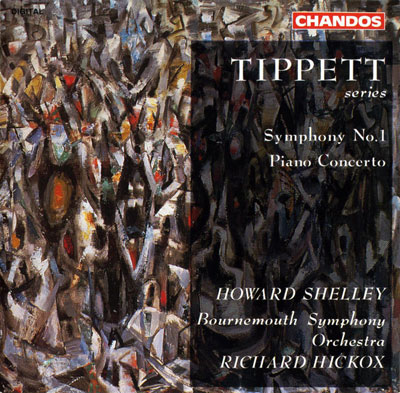
Now in a fever dream, I yearned for another vision. I grabbed my Chandos disc with Michael Tippet’s Symphony No. 1 and Piano Concerto. Tippett was Vaugh Williams’s junior and incorporated more atonal elements in his work. This doesn’t mean his music lacks tenderness. Both of these pieces have moments of lyric beauty. A few bars into First Symphony’s Adagio can only be described as a poignant clarinet solo. It is a mesmerizing moment as the melody floats above the violas, each note rendered with clarity and warmth. When I closed my eyes, I could see the ruins of Morley College after suffering an attack by The BIitz. I encountered a similar moment in the Second Movement of Tippet’s Concerto for Piano and Orchestra.
It opens with the bassoons and French horns playing a series of polyphonic chords that evoke a sense of foreboding. Even though the notes are close together, each instrument retained its distinctive character while producing eerie overtones. Then the flutes took over with what at first was a sweet melody which quickly morphed into one that became strained and increasingly dissonant from the rest of the orchestra. The effect was both beguiling and unsettling at the same time. Listening to this recording with the Le DAC 2, I was transfixed by the entirety of this movement by its mixture of beauty and dissonance. It transported me back to the dank cell in “The Scrubs” where Tippett spent two months for his pacifism. The Spice was increasing my awareness.

Feeling heady, I was ready to immerse myself in the music of Szymanowski. Later in his career, Szymanowski derived inspiration from his folk melodies from his homeland of Poland and his travels around the Mediterranean. This added mystic and exotic elements to his later works. A great collection of this music is the 3rd and 4th Symphonies and Stabat Mater performed by the LSO under the direction of Valery Gergiev. Of the three, the 4th Symphony is my favorite. It is a piano concerto in disguise. Under the spell of the Spice, I was swept away by Szymanowski’s vivid orchestration and use of folk idioms in the first movement. Listening to the LSO perform, I had a vision of the Tatra Mountains covered in snow against a bright blue sky. The wind was whistling through the trees and forming waves on an aquamarine glacial lake. Not a bird dared to sing in this desolate landscape.
The second movement started and my vision changed. Suddenly I was bathed in the reflected sunlight from the River Vistula and before stretched the skyline of Warsaw. In the middle of the skyline was the imposing Soviet-era Palace of Culture and Science. But people walked by it, unafraid of what it represented. Then as the last movement began, my vision changed once more. It started with thousands marching down the street in solidarity that over several minutes dissolved into a mass of people with no clear direction. Then the music was over and I was once again back in my living room.
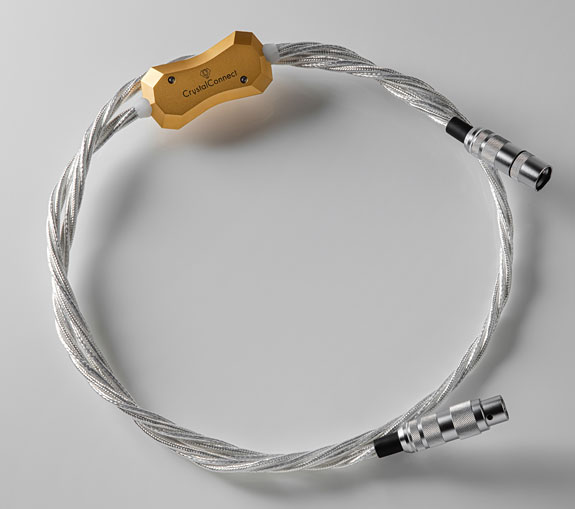
I thought I had reached the limit of what I could experience with the Le DAC 2 when Wynn Wong suggested I upgrade my digital cable. I had been using a lower-priced cable constructed with premium quality RG-6/U with double copper braid shielding. Wynn thought I could experience more with the Crystal Cable Van Gogh digital cable. Van Gogh utilizes their Infinite Silver Crystal conductor with a silver-plated copper mu-foil and PTFE insulation. When they arrived, I marveled at their beauty and solid construction. I knew this cable would enhance the use of the Spice, but how much?
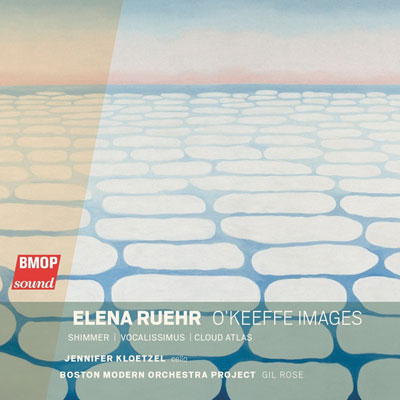
I decided to put on some Elena Ruehr. I have always found her music incredibly evocative. While I do love O’Keefe Images, I was afraid that the visions I might have would not be fit for print. Instead, I focused on Cloud Atlas, based on the book of the same title. The solo cello dominates this piece and Kloetzel’s playing is magnificent. I was marveling at how the Van Gogh cable had added warmth and soul to this piece when I was transported above the Pacific Ocean. I flew over it, arms outstretched as I breathed in the salty air. Volcanic archipelagos whizzed past me as I looked down upon pods of whales. I slowed and dropped lower until I was swimming in the middle of the ocean. I suddenly felt very small bobbing in warm water, anxious about what would happen next. But then the piece ended, and I was left alone with my thoughts about my mortality.
So how did the Le DAC 2 – Van Gogh combination do? It just cranked up the Spice experience even more. Instead of just eating the Spice, I was breathing in the Spice gas like a Guild Navigator. Every note was full of nuance and drama. After several hours of listening to the Le DAC 2 with the Van Gogh cable, I felt my body starting to mutate like a Guild Navigator. Not only were my eyes turning blue, but my primary auditory cortex was growing with all of the new musical information it was being fed. As I breathed in the Spice gas, all time and space melted away, and became one with the music.
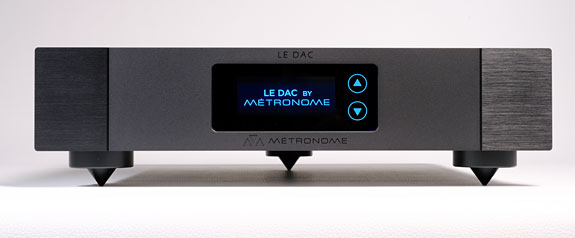
Conclusion
“The mystery of life isn’t a problem to solve, but a reality to experience. A process that cannot be understood by stopping it. We must move with the flow of the process. We must join it. We must flow with it.”, Jamis from Dune (2021).
As I finish this review, I am inspired by this thought. My journey as an audio reviewer has many twists and turns. Sometimes I have actively pursued certain gear, other times stuff has dropped in my lap. I never expected to review any other components from Metronome Audio after reviewing the original Le DAC. Their Kalista brand is the stuff of audiophile dreams. I needn’t have worried when the Le DAC 2 arrived at my door. While the original Le DAC gave me a Technicolor dream, the Le DAC 2 let me peer right into the soul of the music. I was no longer listening to the music, I was experiencing it. I decided to take advice from Jamis. I am moving with the flow and joining all those artists as they share with me what can only be expressed through music.
| Tonality |  |
| Sub–bass (10Hz – 60Hz) |  |
| Mid–bass (80Hz – 200Hz) |  |
| Midrange (200Hz – 3,000Hz) |  |
| High Frequencies (3,000Hz On Up) |  |
| Attack |  |
| Decay |  |
| Inner Resolution |  |
| Soundscape Width Front |  |
| Soundscape Width Rear |  |
| Soundscape Depth |  |
| Soundscape Extension Into Room |  |
| Imaging |  |
| Fit And Finish |  |
| Self Noise |  |
| Emotionally Engaging |  |
| Value For The Money |  |

Check out Enjoy the Music!
See many great reviews by Enjoy the Music.com at this link.
Specifications
Type: Type: Digital-to-analog converter
Resolution: Up to 384 kHz and DSD up to 512 (DSD x8).
Analog Outputs: Class A
Dynamic range: 123 dB
Analog Outputs: Unbalanced 3 V RMS @0dB – 47 KOhms – RCA connectors
Balanced 3 V RMS @0 dB – 600 Ohms – XLR connectors
Power Supply: Two toroidal transformers with six independent regulation lines
Dimensions: 425 x 130 x 415 mm (LxHxW)
Weight: 12 kgs.
Price: $8100
Company Information
Metronome Technologie
166 Rue du Castellet
Z.A. Garrigue Longue
F-81600 Montans
France
Voice: +33(0)5 34 26 11 33
E-mail: contact@metronome.audio
Website: Metronome.audio
USA & Canada Distributor
Wynn Audio Corperation
20 Wertheim Crt, Unit 31
Richmond Hill, ON, L4B 3A8
Canada
Voice: (212) 826-1111
E-mail: wynn@wynnaudio.com
Website: WynnAudio.com














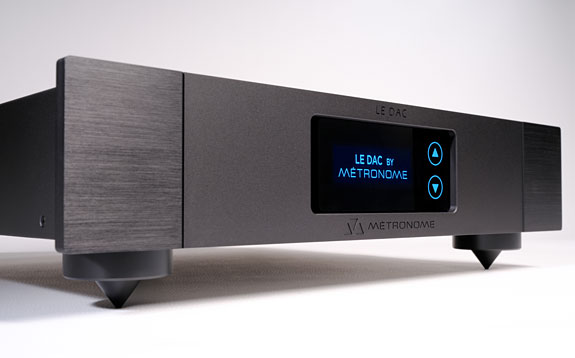
Want to join discussion?
Feel free to contribute!